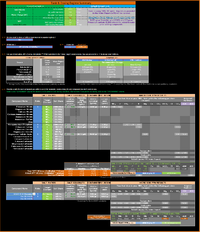@Deano3 how did this mix end up working for you in comparison to apt complete?
I also have a few questions to replicate apt complete specifically for @Zues. and @Hanuman ( thanks for all your detailed help in this thread so far) Its my first time mixing nutrients and I’m using the calculator – I had to change the dose to 4ml daily from 3ml because using potassium sulfate was pushing the solubility too high. (Screenshot attached of what i hope is the final mix)
Context for questions: I am considering GLA’s PPS-Pro EDTA + DTPA package since online it says ph effects iron and it has the macro ferts. I wasn’t sure if that meant just the ph of the fert solution in the bottle or the ph of the tank, so I figured this covered all bases. My fish tank ph ranges from 7.6 to 6.6 reduced w/ Co2 and GH/KH also varies throughout the week as I have seriyu stone leaching minerals into the water rising as the week goes on. I do water changes once every 1-2 weeks with RO water remineralize to 80-90ppm via salty shrimp gh+.
Questions:
I also have a few questions to replicate apt complete specifically for @Zues. and @Hanuman ( thanks for all your detailed help in this thread so far) Its my first time mixing nutrients and I’m using the calculator – I had to change the dose to 4ml daily from 3ml because using potassium sulfate was pushing the solubility too high. (Screenshot attached of what i hope is the final mix)
Context for questions: I am considering GLA’s PPS-Pro EDTA + DTPA package since online it says ph effects iron and it has the macro ferts. I wasn’t sure if that meant just the ph of the fert solution in the bottle or the ph of the tank, so I figured this covered all bases. My fish tank ph ranges from 7.6 to 6.6 reduced w/ Co2 and GH/KH also varies throughout the week as I have seriyu stone leaching minerals into the water rising as the week goes on. I do water changes once every 1-2 weeks with RO water remineralize to 80-90ppm via salty shrimp gh+.
Questions:
- Do either of you agree with my thinking and EDTA + DTPA would be better or should i stick to just EDTA? ( I ask because the EDTA + DTPA option is not contained in the calculator and I don’t want to mess this up by going off on my own and trying a new fert)
- Is the fish tank water ph relevant when selecting nutrients or just the solution in the fert bottle?
- What is the max length of time I can realistically keep nutrients at room temp and what is the best way to extend the max amount of time? ( I was aiming to make a batch that would last me either 26 or 52 weeks, ~750 or ~1500 ml ) It seems like NilocG and APT have found a way to have their ferts not expire rapidly outside of refrigeration, so I’m hopeful I can replicate
- Do I need to shake the nutrients over time or will they always be suspended equally in the solution?
- I know Dennis doesn’t release his trace fert information, but looks like theres a lot of different trace fert options online. How does one pick the best trace fert mix to match what is theoretically in apt complete ( best guess ) and should I be targeting a different one than GLA's? or is there no real way to know this/it doesn’t matter?
- Being that im making an AIO, can i mix everything in a single large container or do i still need to use the special bottles that come in the fert mixing kits and make 500 ml at a time?
Thanks in advance for helping out this newbie!






